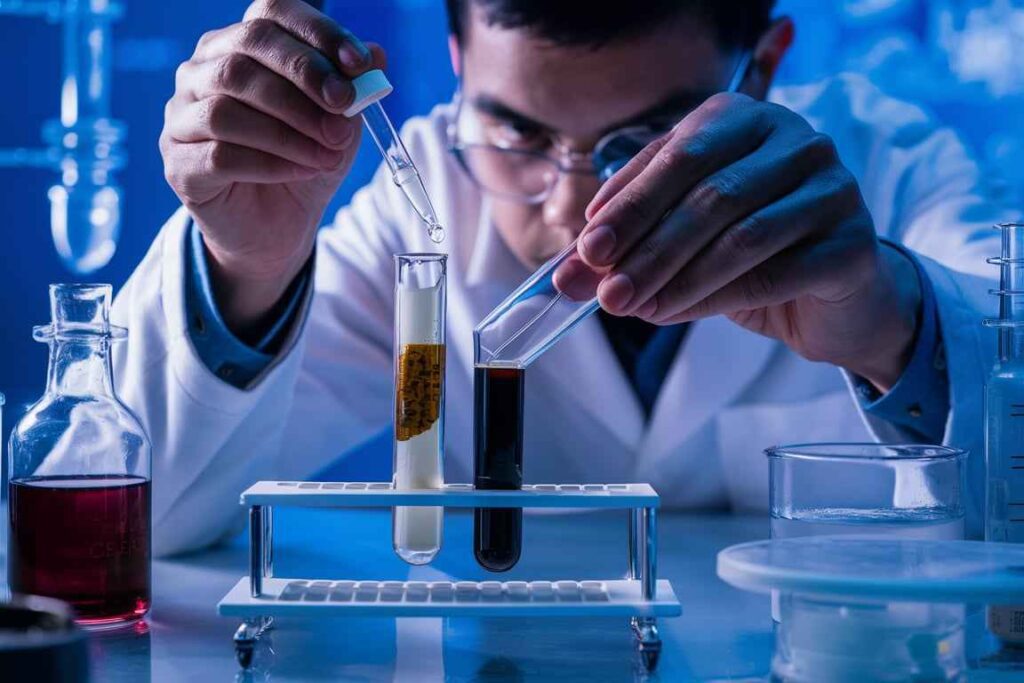Bile solubility test is used to differentiate Streptococcus pneumoniae from other alpha-hemolytic streptococci based on the ability of S. pneumoniae to lyse in the presence of bile salts.
Table of Contents
Bile solubility test
Bile solubility test is based on the unique ability of Streptococcus pneumoniae to lyse in the presence of bile salts (typically sodium deoxycholate). This lysis occurs due to the activation of the autolysin enzyme present in S. pneumoniae, which leads to the breakdown of the bacterial cell wall. Other alpha-hemolytic streptococci do not possess this enzyme in the same manner and therefore do not undergo lysis when exposed to bile salts.

One useful diagnostic technique for differentiating Streptococcus pneumoniae from other alpha-hemolytic streptococci is the bile solubility test. In clinical microbiology, this distinction is essential since Streptococcus pneumoniae is a major pathogen that causes a number of illnesses, such as sepsis, meningitis, and pneumonia. Gaining knowledge about the bile solubility test’s principles, methods, and interpretation will help in correctly diagnosing and treating illnesses brought on by this bacteria.
Principle
The capacity of bile salts—typically sodium deoxycholate—to lyse Streptococcus pneumoniae cells provides the basis for the bile solubility test. Bile salts trigger the S. pneumoniae enzyme autolysin, which causes cell lysis. Since other alpha-hemolytic streptococci do not have this enzyme in the same way, they are unable to lyse when bile salts are present.
The basis for the bile solubility test is Streptococcus pneumoniae’s distinct vulnerability to lysis by bile salts, most commonly sodium deoxycholate. The test takes use of S. pneumoniae’s autolysin enzyme, which is essential to the bacterium’s metabolism of its cell walls. During cell division, autolysin helps with cell wall turnover and separation. When bile salts are added, this enzyme is activated, which causes the bacterial cells’ cell wall to break down and lyse. Alpha-hemolytic streptococci can be distinguished from other related species easily because they lack autolysin in the same way and are therefore unaffected by bile salts.
Process
Materials Required:

Sodium deoxycholate, typically 2%, in the bile salts solution
Saline that has been sterilized or phosphate-buffered (PBS)
Immunization loop
Microscopic Incubator (optional for verification)
Steps:
Inoculum preparation:
Take a loopful of the alpha-hemolytic streptococci bacterial culture off of a blood agar plate.
To make a turbid suspension, suspend the bacteria in 1 milliliter of PBS or sterile saline.
Include bile salts:
Split the suspension into two portions of the same size.
Equal parts of 2% sodium deoxycholate solution should be added to one part.
Add an equivalent volume of sterile saline or PBS to the other portion to keep it as a control.
Incubation Period:
For ten to fifteen minutes, incubate both tubes at 35–37°C.
Remark:
Look for any changes in the tubes. A favorable outcome is shown by the bacterial suspension’s lysis.
Result

Positive Result:
- Look: The bile salt suspension turns transparent, signifying that the bacterial cells have been lysed.
- Interpretation: Because it dissolves in bile, this suggests the presence of Streptococcus pneumoniae.
Negative Result:
- Visual appearance: There is no bacterial cell lysis in the bile salt suspension, which keeps it murky.
- Interpretation: This suggests that there exist non-bile soluble alpha-hemolytic streptococci.
Frequently Asked Question
What is Bile solubility test ?
Bile solubility test is based on the unique ability of Streptococcus pneumoniae to lyse in the presence of bile salts (typically sodium deoxycholate). This lysis occurs due to the activation of the autolysin enzyme present in S. pneumoniae, which leads to the breakdown of the bacterial cell wall.
What is the principle of solubility test?
The principle of the bile solubility test lies in the unique susceptibility of Streptococcus pneumoniae to lysis in the presence of bile salts, specifically sodium deoxycholate.
What is the bile juice solubility test?
The bile solubility test is a diagnostic procedure used to differentiate Streptococcus pneumoniae from other alpha-hemolytic streptococci based on their response to bile salts, typically sodium deoxycholate.
Related Article




